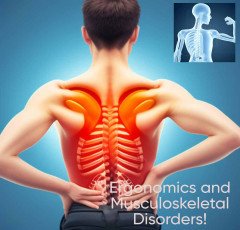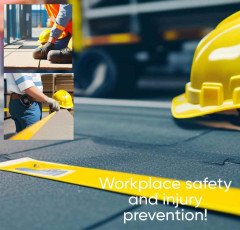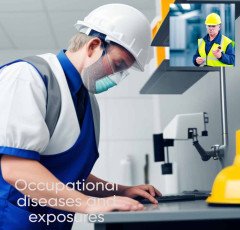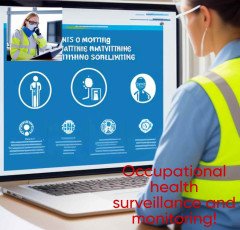
Ergonomics and Musculoskeletal Disorders

The study of human interaction with the workplace and its design for optimum performance and well-being is known as ergonomics.
It entails creating tools, jobs, and workspaces that are tailored to the users in order to lessen discomfort, weariness, and accidents while boosting productivity and efficiency.
Musculoskeletal diseases (MSDs), which commonly develop from repetitive motions, uncomfortable postures, and excessive force, are illnesses that affect the muscles, tendons, ligaments, and nerves of the body. MSDs can result in lower productivity, missed workdays, and long-term incapacity. They can also cause pain, numbness, tingling, weakness, and stiffness.
MSD incidence and prevention are significantly impacted by ergonomics.
Ergonomic treatments can lower the incidence of MSDs, enhance general wellbeing, and increase productivity by creating work settings and equipment that support healthy postures and motions.
Typical illustrations of ergonomic improvements that can aid in the prevention of MSDs include:
In order to encourage good working conditions and prevent MSDs, ergonomics should be taken into account in every workplace.
Employers can increase employee productivity and well-being by introducing ergonomic treatments and promoting healthy work habits.
Many businesses, especially those that require repeated motions or extended periods of sitting or standing, struggle with MSDs.
Back pain, tendinitis, and carpal tunnel syndrome are a few of the most typical MSDs. These illnesses can have a negative impact on a person's quality of life and be unpleasant and incapacitating.
Employers are accountable for providing a safe and healthy work environment for their employees, which includes using ergonomic treatments to reduce the risk of MSDs. Ergonomic treatments can help employees physically as well as financially for organizations. Employers can minimize healthcare expenditures, lower absenteeism, and increase productivity by reducing the prevalence of MSDs.
To inform your employer and get medical help if you're showing signs of an MSD.
Early diagnosis and treatment can increase your chances of recovery and help stop the illness from getting worse.
The study of ergonomics is crucial because it can assist prevent and lower the prevalence of MSDs in the workplace.
Employers can boost productivity and employee well-being by creating workspaces and office furnishings that encourage wholesome postures and movements.
To remember that ergonomics is not only relevant in the workplace.
It can also be used for regular tasks like driving, gardening, and housework. People can lower their risk of developing MSDs and enhance their general wellbeing by applying ergonomic concepts to these activities.
Additionally, ergonomics encompasses more than just physical aspects.
It can also be used to address psychological and emotional issues including stress and workload. Employers may enhance their employees' mental and emotional well-being, which can therefore improve their physical health and lower the risk of MSDs, by lowering stress and encouraging a healthy work-life balance.
For people and organizations who wish to learn more about ergonomics and how to put ergonomic interventions into practice, there are a lot of materials accessible. Guidelines and tools for ergonomic design and injury prevention are offered by occupational health and safety agencies, such as the Occupational Safety and Health Administration (OSHA) in the United States.
Furthermore, there are a variety of ergonomic gear and goods on the market, including chairs, keyboards, and mouse, that can assist good posture and mobility. It's crucial to remember, nevertheless, that adopting ergonomic items alone is insufficient. It's crucial to check that the entire workplace is set up to encourage healthy postures and motions.
The study of ergonomics is a complicated field that takes into account a wide range of elements, including emotional, mental, and physical health. Employers and people can improve overall quality of life, lower the risk of MSDs, and promote the health and well-being of themselves and others by embracing a holistic approach to ergonomics and putting a variety of interventions into place.
More importantly, ergonomics is a never-ending process.
It's critical to continuously evaluate and modify ergonomic solutions as work environments, jobs, and technologies evolve to ensure their efficacy.
Employees can stay aware and involved in ensuring a safe and healthy workplace by receiving regular training and instruction on ergonomic concepts and injury prevention. Regular assessments of the working environment and job duties can also aid in locating potential risk factors and chances for development.
Employers and people can foster a culture of safety and wellbeing that fosters productivity, creativity, and general health by adopting a proactive and continuing ergonomics strategy.
The study of designing the workplace, tools, and tasks for optimum human performance and well-being is known as ergonomics.
This entails creating workplaces and equipment that are tailored to the demands of the users, encouraging appropriate postures and movements, alleviating discomfort, and preventing musculoskeletal illnesses.
Musculoskeletal diseases (MSDs), which commonly develop from repetitive motions, uncomfortable postures, and excessive force, are illnesses that affect the muscles, tendons, ligaments, and nerves of the body. MSDs can result in lower productivity, missed workdays, and long-term incapacity. They can also cause pain, numbness, tingling, weakness, and stiffness.
MSDs can be prevented and their frequency can be decreased using ergonomic treatments.
As part of these treatments, workstations are changed, ergonomic tools and equipment are provided, regular breaks are encouraged, proper lifting and handling procedures are taught, and physical activity is promoted.
In order to ensure good working conditions and prevent MSDs, ergonomics is a crucial factor in any workplace.
Employers have a duty to create a safe and healthy work environment for their employees, and putting ergonomic interventions into place is a crucial element of upholding that duty. Employers can save healthcare expenses, cut down on absenteeism, and boost productivity by minimizing the prevalence of MSDs.
It is significant to highlight that ergonomics is not merely concerned with physical aspects.
Stress and workload are two additional mental and emotional elements that are included. Fatigue, a loss of focus, and an increase in the risk of MSDs can result from high stress and workload levels. In order to foster a healthy work-life balance and lessen stress, companies should also think about these strategies.
The consideration of individual characteristics in the workforce is a crucial component of ergonomics.
Everybody has particular physical prowess, constraints, and preferences. In order to satisfy the demands of all employees, companies should make an effort to develop a work environment that does so.
It's also important to remember that ergonomic interventions are not just for people who have MSDs already.
To lower the likelihood of first developing MSDs, preventative measures are also crucial.
The study of ergonomics is a broad topic that takes into account a variety of elements, including emotional, mental, and physical health. Employers can improve their employees' productivity and quality of life by promoting their health and well-being, lowering the risk of MSDs, and implementing a variety of interventions by adopting a comprehensive approach to ergonomics.
To emphasize that there is no one size fits all for ergonomic solutions.
Employers should evaluate the unique requirements of their employees and adapt ergonomic treatments as necessary. This may entail asking workers for input, performing ergonomic exams, and speaking with ergonomics experts.
To ensure the success of their ergonomic treatments, employers should continuously review and enhance them.
In order to do this, it may be necessary to routinely examine injury and sickness statistics, get employee feedback, and stay current with ergonomic best practices and research.
In general, ergonomics is a crucial component of occupational health and safety.
Employers can establish a safe and effective work environment that supports the wellbeing of their workforce by creating workspaces and tasks to match the needs of employees, supporting healthy movements and postures, and lowering the risk of MSDs.
Designing tasks, tools, and work settings to promote human performance and well-being is known as ergonomics.
Musculoskeletal diseases (MSDs) are frequent workplace accidents that can be brought on by uncomfortable postures, repeated actions, and excessive force. By changing workstations, providing ergonomic tools and equipment, encouraging regular breaks, and offering instruction on safe lifting and handling procedures, ergonomic treatments can help prevent and minimize the incidence of MSDs.
To emphasize that ergonomics encompasses both mental and emotional aspects, such as stress and workload, in addition to physical ones.
Employers need to think about how to lessen stress and encourage a good work-life balance. Additionally, businesses should tailor ergonomic solutions to the particular needs of each individual.
Employers should continuously assess and enhance their ergonomic interventions to ensure their efficacy because ergonomic solutions are not universally applicable. Employers may foster a healthy work environment that supports employee wellbeing, lowers the risk of MSDs, and boosts general productivity and quality of life by applying ergonomic treatments.















 Online Marketing
Online Marketing  Kitchen Tap
Kitchen Tap  Door Handle Collection
Door Handle Collection  NordLocker
NordLocker  TitTok Revolution
TitTok Revolution  Hello Theme
Hello Theme  Digital Voice Recorder
Digital Voice Recorder  Dell Laptop
Dell Laptop  Samsung Mobile
Samsung Mobile  Top Rated From Amazon
Top Rated From Amazon  Echo Dot - Smart speaker with Alexa
Echo Dot - Smart speaker with Alexa  Women Fashion
Women Fashion  Acer Laptop
Acer Laptop  iPhone cable
iPhone cable  Dual USB Car Charger
Dual USB Car Charger  Unlimited access to classes on illustration, photography, design, film, music
Unlimited access to classes on illustration, photography, design, film, music  Only For The United States
Only For The United States  Sennheiser
Sennheiser  Best Robotic Vacuum Cleaners
Best Robotic Vacuum Cleaners  Smart Doorbell
Smart Doorbell  Stylish Sneakers by Red Tape
Stylish Sneakers by Red Tape  The Click Engine
The Click Engine  HP Laptop
HP Laptop  4k Projector For Home
4k Projector For Home  Healthy Ingredients
Healthy Ingredients  Prime Video
Prime Video  Unreal Engine 5 For Beginners Learn The Basics Of Virtual Production
Unreal Engine 5 For Beginners Learn The Basics Of Virtual Production  Best Selling Books
Best Selling Books  Duke T Shirts
Duke T Shirts  Essentials for Gamers
Essentials for Gamers  Hanging Lights For Living Room
Hanging Lights For Living Room  Favorite Company (Cuelinks)
Favorite Company (Cuelinks)  Amazon Best Selling Products
Amazon Best Selling Products  Wireless Gaming Mouse
Wireless Gaming Mouse  Artificial Intelligence
Artificial Intelligence  One World Collection
One World Collection  Kitchen Daily Use
Kitchen Daily Use  Pet Care Products
Pet Care Products  SEO Checklist
SEO Checklist  BEST SELLER TOP10
BEST SELLER TOP10  Air Purifier for Home
Air Purifier for Home  Rakhi
Rakhi  ELECTRONIC ACCESSORIES
ELECTRONIC ACCESSORIES  Men Clothing
Men Clothing  Home Decor Items
Home Decor Items  Bathroom Mirrors
Bathroom Mirrors  ASUS Laptop
ASUS Laptop  NordVPN
NordVPN  Best Sellers On Amazon
Best Sellers On Amazon  Online Technology Classes
Online Technology Classes  Adidas Shoes
Adidas Shoes  Wristbands
Wristbands  Best Home Appliances
Best Home Appliances  The Secret Email System
The Secret Email System  Hot Bags For Pain Relief
Hot Bags For Pain Relief  Best Phone
Best Phone  1150+Trendy kids coloring pages Bundle
1150+Trendy kids coloring pages Bundle  RPM 3.0
RPM 3.0  Realme Smart Phone
Realme Smart Phone  Wireless Bluetooth Earphones
Wireless Bluetooth Earphones  Creative Brief For Video Shoot
Creative Brief For Video Shoot  LCD Writing Tablet
LCD Writing Tablet  ASPINAL LONDON
ASPINAL LONDON  Graphics & Design
Graphics & Design  Apple iPhone
Apple iPhone  Puma (Clothing & Accessories)
Puma (Clothing & Accessories)  Smart Watches
Smart Watches  NordPass
NordPass  Wall Lamp
Wall Lamp  Motion Sensor Light
Motion Sensor Light  All Wireless Products
All Wireless Products  Crocs
Crocs  SOFAS
SOFAS 


















